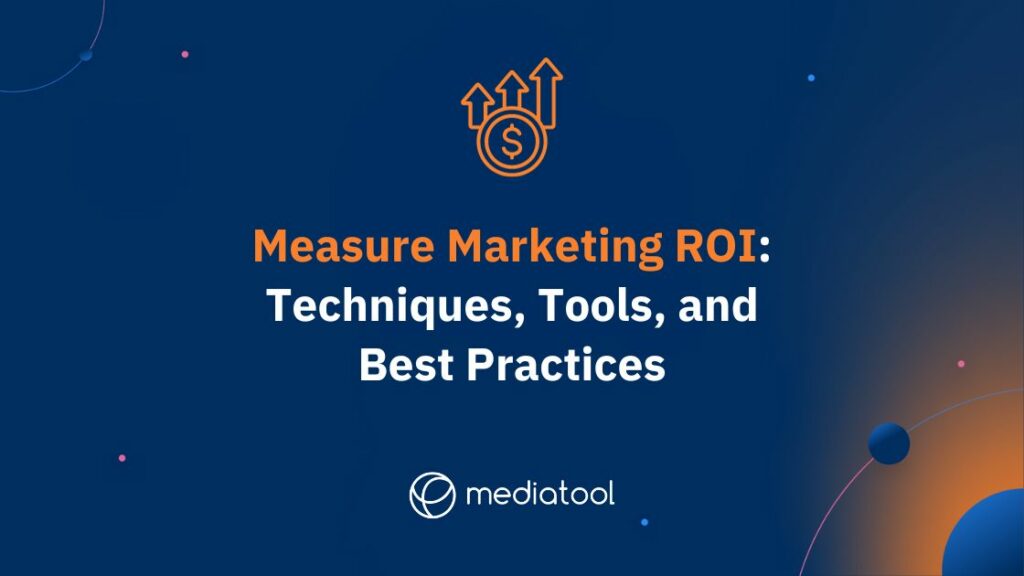As a marketer in the fast-changing world of digital marketing, you know the drill: measuring marketing ROI is crucial. But let’s face it, it often feels like chasing a mirage. The mere mention of “marketing ROI” in strategy meetings might set your heart racing.
The digital advertising scene is a moving target, constantly altering the marketing mix. Yesterday’s winning strategies may not work today, and you find yourself navigating through a maze of data, looking for solid ground.
Yet, mastering marketing ROI isn’t a mythical task. It demands some number work and strategic thinking, but the rewards? Immense. Knowing how to accurately measure marketing ROI sheds light on where your marketing spend is actually going and which of your marketing campaigns are hitting the mark.
With precise marketing ROI calculations, you gain the power to sharpen your marketing strategies. This isn’t just about improving marketing ROI; it’s about making informed decisions that propel profit and customer lifetime value upward.
Are you set to get down to the nitty-gritty of ROI calculation and ready to prove the real worth of your marketing efforts? Looking to distribute your marketing budget in a way that amplifies returns across all channels, from social media to email marketing, from customer relationship management to sales growth?
This guide aims to take you from juggling numbers to confidently steering your marketing campaigns toward greater marketing success. It’s time to get your marketing team geared up for this journey – to calculate marketing ROI and make it the beacon for your marketing efforts, driving forward revenue growth and marketing performance.

What is ROI in Marketing?
In the bustling marketing world, ROI—Return on Investment—is your guiding star. It measures whether the cash funneled into your marketing efforts boosts your bottom line. Calculating marketing ROI isn’t just about tallying up immediate returns; it’s a dynamic metric that reflects the profitability of your digital marketing campaigns and the efficiency of your marketing spend.
As you hone your marketing strategies, from social media marketing to Google search ads, ROI keeps you focused on profit and revenue growth. It’s not just a static figure; it evolves with your marketing mix, driving decisions on marketing costs and allocating your marketing budget. It even captures the long-term value of customer relationships, considering the full customer journey—from email marketing touches to direct sales conversions.
A robust ROI calculation accounts for both marketing expenses and the subtler aspects of marketing success, like customer retention and engagement via social media posts. It’s essential for marketing teams who aim to justify their investment with clear evidence of increased sales and a healthy marketing return.
Monitoring ROI is about optimizing your marketing activity to ensure each dollar spent is an investment in future growth, navigating through the digital advertising landscape towards a strong marketing performance and, ultimately, a high ROI.
Why is Marketing ROI Important?
You might think, “Alright, I’ve got this ROI thing down, but why is it so essential?”
Excellent question.
Let’s take a look into that.
Measuring ROI is akin to taking your marketing campaign’s pulse. For example, companies engaging in influencer marketing are witnessing palpable success, with returns averaging $5.78 for each dollar invested.
This illustrates the pulse of a healthy campaign—vigorous and profitable. It’s all about understanding the effectiveness of your campaigns. Are your initiatives driving profits, generating sales, or are they falling flat? ROI answers these pressing questions, giving you a solid idea of whether your strategies are hitting their mark.
ROI brings clarity to your marketing expenses. Let’s face it. Marketing campaigns can be costly endeavors. You’re putting time, effort, and, of course, money into them. ROI helps ensure these resources aren’t going down the drain. It lets you see where your dollars have the most significant impact and where they might be better spent.
Another crucial point is that improving marketing ROI is all about accountability. It holds your marketing initiatives responsible for generating profits. Nearly half of marketers report that ROI is the paramount metric for their company’s executives, including the CEO, CFO, and board members, underscoring its significance in corporate decision-making. When you invest in a marketing strategy, you’re betting on its success. And like any smart bettor, you need to track your bets’ performance. ROI provides a lucid and quantifiable measure of your marketing performance, revered across the executive board.
ROI also plays a crucial role in decision-making. When planning your marketing strategies, you have a whole array of options. Should you use that striking social media marketing campaign or invest in search engine optimization? Where should you channel your resources for maximum impact? By comparing the ROI of your past strategies, you can make informed decisions about future campaigns.
And finally, remember that ROI isn’t just a metric. It’s a culture. By prioritizing ROI, you’re cultivating a mindset of efficiency and profitability within your organization. You’re encouraging your team to view marketing not as an expense but as an investment—an investment expected to yield returns and drive the growth of your business.
How to Calculate Marketing ROI of Your Marketing Campaigns

Welcome to the meaty part! Calculating ROI for digital marketing may seem daunting, but it doesn’t have to be. Think of it like solving a fun puzzle, the pieces of which are your marketing investments and profits. Let’s break it down and turn you into an ROI-calculating wizard!
First off, let’s understand the basic marketing ROI formula.
It’s (Sales Growth – Marketing Cost) / Marketing Cost multiplied by 100 to get a percentage.
Don’t run away just yet! It’s more straightforward than it sounds.
Sales growth is simply the increase in sales revenue that you’ve observed during your marketing campaign. If you’re running multiple campaigns, you should attribute this growth to each one. Easier said than done, we know, but hold tight; we’ll get to that tricky part.
Marketing cost is the total amount you’ve spent on a particular campaign. This should include every penny, from the money spent on ads and hiring influencers to the cost of creating content and the time invested by your team. So, make sure you’re keeping meticulous track of all these expenses.
Now, the tricky part. How do you determine the sales growth specifically due to your marketing campaign? Well, it’s an art and a science. You’d ideally subtract your usual sales revenue (without any marketing) from your total sales revenue during the campaign. The challenge lies in defining this ‘usual sales revenue.’ It can be an average of sales during non-campaign periods, or you can use more sophisticated statistical methods to estimate it.
Once you’ve cracked that, you plug your numbers into the ROI formula. Subtract the marketing cost from the sales growth, divide by the marketing cost, and multiply by 100. There you have it, your ROI!
Remember, it’s not just about getting a number. It’s about understanding what that number means. Is it positive? Great, your campaign has been profitable! Is it negative? Don’t fret; it’s an opportunity to learn and improve. Is it a whopping 300%? Wow, you’re a rockstar!
ROI calculation also helps you identify your star-performing platforms. For instance, email marketing remains a high-yield strategy, with an impressive average return of $36 on every dollar invested, showcasing its effectiveness in generating leads and driving sales. By calculating the ROI for each platform or campaign, you can pinpoint these all-stars and allocate more resources to them for even greater returns.
But here’s a word of caution: don’t fall into the trap of obsessing over immediate ROI. Digital marketing often has long-term impacts on customer lifetime that can’t be captured in immediate ROI. A customer may bookmark your website during a campaign and make a purchase weeks later. So, while immediate ROI is a crucial measure, don’t overlook the long-term value of your marketing efforts.
What’s a Good Digital Marketing ROI?
The million-dollar question – what’s a good digital marketing ROI? Well, much like the answer to “How long is a piece of string?” it can be pretty subjective. But don’t worry; we’ll unpack this complex question to make it as easy as pie.
Generally, a positive ROI is a good start. This means you’re earning more than you spend on your marketing efforts. But let’s get a bit more specific. Many businesses operate on an average ROI of 5:1. That means for every dollar spent, five dollars is earned. Not bad, right? However, this is a ballpark figure, and what’s considered ‘good’ can vary based on your industry, business model, market conditions, and the specific marketing channel used.
Also, when talking about a good ROI, it’s crucial to consider the context. A 10:1 ROI might seem fantastic, but if it only results in a minuscule portion of your overall revenue, it might not be as impressive as it sounds. Conversely, a smaller ROI ratio contributing significantly to your sales might be more valuable to your business.
Furthermore, remember that the nature of your marketing campaign influences the expected return on investment ROI amount. Brand awareness campaigns, for instance, might not yield immediate returns but can lead to long-term customer loyalty and sales growth. In contrast, a specific product promotion may result in an immediate sales spike. Therefore, aligning your ROI expectations with your campaign goals is essential.
Another key consideration is your customers’ lifetime value (LTV). If your marketing efforts bring in customers who make larger, repeated purchases over time, a lower initial ROI might still be pretty good. It’s like playing a long game. You might not win big immediately, but your long-term gains can be substantial.
It’s also vital to look at your ROI in relation to your marketing budget. A small business might be thrilled with an ROI that many marketers at a large corporation would consider insignificant. That’s why keeping your expectations realistic and in tune with your specific circumstances is essential.
Now, don’t let these complexities deter you. The beauty of ROI lies in its flexibility. It’s not about striving for an elusive ‘perfect’ number but continuously improving your ROI over time. It’s about learning from each campaign’s success, tweaking your strategies, and constantly reaching for a higher bar.
What Are the Challenges of Measuring Marketing ROI?
Calculating marketing ROI might seem straightforward, but it’s more like a complex hike than a casual stroll. Sales attribution to specific marketing campaigns poses a major puzzle in measuring ROI, as does accounting for the attribution problem across digital marketing platforms. Time lag further complicates calculating marketing ROI, as consumer actions like bookmarking can delay purchases, making immediate ROI challenging to measure.
External market fluctuations and competitor activities can skew your marketing ROI calculation, much like unpredictable weather affects driving conditions. Measuring marketing efforts also involves quantifying intangible gains like social media engagement and positive reviews—crucial for long-term success but difficult to factor into immediate ROI calculations.
Accurate data on marketing spend, sales growth, and marketing costs are crucial for precise ROI calculation, but gaps or inaccuracies in data can distort your ROI, making the quest for high ROI as meticulous as fine-tuning a marketing strategy. Remember, a good marketing ROI isn’t just about numbers; it reflects customer lifetime value, marketing success, and the health of customer relationships.
How to Improve Your Return on Marketing Investment

If your ROI calculations show that your marketing ROI is underperforming, don’t worry—it’s time to sharpen your marketing strategies for better returns on your investment.
Refine Your Marketing Campaign Targeting
To enhance marketing ROI, ensure your marketing campaigns resonate with the right audience. Implementing personalized marketing strategies has significantly boosted company returns, enhancing marketing ROI by a substantial 10 to 30 percent. Precise targeting, which often involves personalization, means your ad spend goes directly to potential customers most likely to respond to your digital marketing efforts, such as those tailored Google search ads.
Streamline Your Marketing Efforts
Assess which marketing channels are driving sales growth and which are not. Focus your marketing budget on proven strategies that generate website traffic and direct sales, like email marketing or social media marketing. Eliminating underperforming marketing activities can reduce marketing costs and improve ROI.
Leverage Testing for Campaign Success
Continuous A/B testing helps refine your marketing initiatives. Testing headlines, images, or social media posts ensures your digital advertising stays ahead in the evolving marketing landscape, leading to an improved marketing return on investment.
Invest in Customer Relationships
Focusing on customer retention through effective customer relationship management can significantly increase customer lifetime value. Remember, keeping existing customers costs less than acquiring new ones. Retained customers contribute to sustained revenue growth and can improve overall ROI.
Employ Creative Development
Don’t be afraid to innovate in your marketing efforts. Creative development might lead to a marketing breakthrough, setting you apart and increasing your marketing ROI. Monitoring your marketing performance with key performance indicators (KPIs) will guide you toward a high ROI.
Optimize ROI with Analytics
Use web analytics to measure marketing ROI accurately. This helps adjust your marketing mix and calculates the return on investment for individual campaigns, ensuring you know exactly how your marketing spend translates to profit and revenue growth.
Conclusion
Mastering ROI is crucial in marketing for evaluating the effectiveness of strategies and ensuring budget spends translate into profit and growth. The complexity of calculating ROI, including attributing sales to specific campaigns and understanding long-term customer value, presents challenges that are essential to overcome for strategic decision-making and competitive success in the digital realm.
Marketers must look beyond immediate returns to the full scope of the customer journey, considering the overarching influence of marketing on customer relationships and lifetime value. This comprehensive view of ROI ensures marketing tactics are cost-effective and align with long-term business success.
To boost ROI, marketing teams should focus on targeted campaigns with a specific target audience in mind, efficient allocation of resources, consistent testing, and creative strategies, while maintaining robust customer relations. Utilizing tools like web analytics and A/B testing helps fine-tune these efforts, contributing to better marketing ROI.
Ultimately, marketing professionals are tasked with improving ROI figures and interpreting them as indicators of a campaign’s overall health and effectiveness, driving strategic investments and business growth. Embracing the detailed work of ROI analysis is key to guiding marketing initiatives toward enhanced profitability and triumph.





